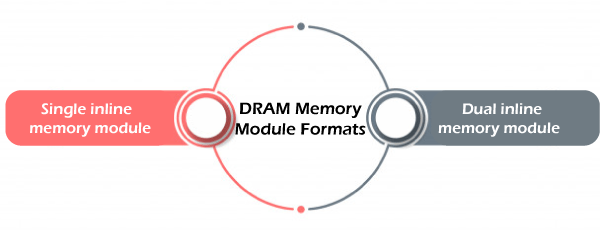DRAM Memory Module Formats

DRAM memory modules come in different formats, which determine their physical design, pin configurations, and compatibility with specific systems. The most common DRAM memory module formats include:
-
DIMM (Dual In-Line Memory Module):
- Description: DIMM is the most widely used form factor for desktop and server memory modules. It features a rectangular design with separate electrical contacts on both sides.
- Versions: Standard DIMMs are available in various generations, such as DDR, DDR2, DDR3, DDR4, and DDR5. They differ in terms of pin configurations, data transfer rates, and other specifications.
-
UDIMM (Unbuffered DIMM):
- Description: UDIMMs are DIMMs without any additional buffer or register. They are commonly used in consumer desktop computers.
- Usage: UDIMMs are suitable for applications where a lower number of memory modules is acceptable, such as in most personal computers.
-
RDIMM (Registered DIMM):
- Description: RDIMMs include a register or buffer that helps to reduce electrical load on the memory controller. This allows for greater module density and stability.
- Usage: RDIMMs are commonly used in servers and workstations where higher memory capacities are required.
-
LRDIMM (Load-Reduced DIMM):
- Description: LRDIMMs take the concept of registered DIMMs further by using an additional buffer to reduce the electrical load even more. This allows for greater memory module density.
- Usage: LRDIMMs are often used in high-density memory configurations, such as servers requiring large amounts of RAM.
-
SO-DIMM (Small Outline DIMM):
- Description: SO-DIMMs are smaller than standard DIMMs, making them suitable for laptops, small form factor computers, and other space-constrained systems.
- Versions: Available in various generations, including DDR, DDR2, DDR3, and DDR4, depending on the laptop or device's specifications.
-
Micro-DIMM:
- Description: Micro-DIMMs are even smaller than SO-DIMMs, designed for use in ultra-compact systems, such as some netbooks and embedded devices.
- Usage: Less common than other form factors, micro-DIMMs are used in specific applications where size is a critical factor.
-
FB-DIMM (Fully Buffered DIMM):
- Description: FB-DIMMs use a fully buffered architecture to allow for greater memory module density. Each module has a memory buffer that reduces electrical load.
- Usage: FB-DIMMs were used in some servers and workstations but have become less common in recent years.
-
NVDIMM (Non-Volatile DIMM):
- Description: NVDIMMs combine traditional volatile DRAM with non-volatile memory, such as Flash or Phase-Change Memory (PCM). This allows data to be saved even when the power is turned off.
- Usage: NVDIMMs are used in applications where persistent memory (non-volatile) is beneficial, such as in certain enterprise and data center environments.
These various form factors cater to the diverse needs of different computing environments, from laptops and desktops to servers and specialized systems. The choice of a specific DRAM module format depends on factors such as system compatibility, performance requirements, and physical space constraints.
Thank you.
